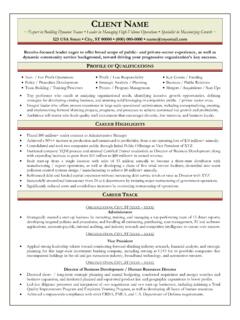Transcription of German Volume Training: An Alternative Method of High ...
1 Conditioning fundamentalsfeatureabout theAUTHOR nsca s performance training journal Volume 8 issue 110 Daniel Baker is a Life Member and President of the Australian Strength & Conditioning Association. His full-time job for the past 14 years is as strength and conditioning coach for the Brisbane Broncos Rugby League team, who participate in Australia s professional National Rugby League (NRL) competition. Before this time he worked with elite athletes from a diverse range of sports such as power-lifting, diving, soccer, and track & field to name a few.
2 He completed his PhD in Sport Science at Edith Cowan University in Perth, Australia, where he is also an Adjunct Lecturer. He can be contacted at Volume training : An Alternative Method of high Volume -Load training For Stimulating Muscle GrowthDaniel Baker, PhD, CSCSI ntroductionResistance training may be implemented to achieve dif-fering outcomes such as increased control and stability, hypertrophy of muscle, maximal strength, power, or strength-endurance. Common among the desired out-comes for many trainers is the hypertrophy or growth of recommendations to develop muscle hypertro-phy include a higher training Volume (eg.)
3 Multiple sets of > 10 repetitions) with shorter rest periods ( < 3-min-utes) at a moderate intensity (60 75% 1RM). Moreover, some research (1) and a large amount of practical train-ing experience also suggests that a higher Volume -load (total repetitions x the weight lifted) is more effective in developing muscle hypertrophy as compared to the same Volume (sets and reps) and intensity performed with exercises that utilize lighter resistances. For example, 3 x 10RM bench press with an 80 kg resis-tance ( Volume -load = 30 x 80 kg = 2400 kg) is presumed to be more effective in developing muscle growth as compared to the Alternative workout of 3 x 10RM chest flies with 15 kg dumbbells ( Volume -load = 30 x 15 kg x 2 each = 900kg).
4 Consequently most trainers and athletes wisely tend to choose a predominance of multi-joint, compound exercises when training to increase muscle growth so that a high Volume -load can be attained to help stimu-late muscle growth. Aligned with these choices is the typical recommendation to choose multiple exercises ( 2 4) to hit the muscle from every angle or in-crease the recruitment of different muscle fibers as typi-cally occurs when performing different exercises for the same muscle groups.
5 But there is an Alternative Method to the common edict of multiple exercises per body part, gleaned apparently, from the training of German olympic-style weightlifters that has been labeled by re-nowned Canadian strength coach Charles Poliquin as German Volume training (GVT) (3).The German Volume training WorkoutThe GVT has been advocated in the coaching and popular media as an effective training Method to help athletes gain lean body mass and muscle size (2, 3).
6 Ac-cording to Charles Poliquin, the GVT workout was pur-portedly developed by German weightlifting coach Rolf Fesser to aid lifters who wanted to increase lean body mass during the general preparation phase of training (3). The original GVT workout entailed the performance of a larger number of sets per exercise (ten sets per ex-ercise) than is typically recommended for hypertrophy-oriented training (2). Specifically, the original GVT train-ing prescription was 10 sets of 10 repetitions performed with about 60% 1RM or a 20 RM resistance.
7 As achieving a high Volume -load with a resistance of around 60% 1RM is the strategic goal of the work-out, the strategy of reducing the resistance by to 5kg after a failed set (where 10 repetitions was not achieved) or when the athlete believes they will fail in the ensuing set, is neces-sary to maintain set lifting Volume at 10 repetitions per set. If athletes attempt to maintain the initial resistance and do fewer repetitions per set due to accumulating nsca s performance training journal Volume 8 issue 111fatigue, then typically some athletes are only able to perform 3 5 repetitions in the last few sets.
8 This procedure drastically reduces potential Volume -load and is not the methodology used for the GVT rationale of the GVT workout is to totally deplete the muscle fibers involved in one key multi-joint exercise, rather than disperse the fa-tigue across Alternative muscle fibers as could occur with multiple exercises (3). If the exercise chosen was a key, compound exercise, then fi-ber recruitment would naturally be high anyway, and it was presumed that a super-compensatory growth response would occur as a result of the high Volume -load training stimulus that was concentrated in the recruited fibers (3).
9 Accord-ingly, exercises such as squats, bench presses, deadlifts or pulls, pull- or chin-ups are dominant exercise choices for the GVT Poliquin has recommended modifying the original GVT so that an agonist-antagonist pairing of exercises can be used with sets of a key agonist heavy resistance multi-joint exercise alternated with sets of an antagonist second-ary movement (3). For example, bench press sets may be alternated with a row exercise or pull-ups with dumbbell shoulder presses.
10 The agonist exercise is the main focus of the workout and each GVT complex can be considered as ei-ther an entire workout or at least the dominant portion of a workout. Typically each complex of the GVT starts every 3-minutes, consequently the entire GVT workout lasts 30-minutes. An abdominal training exercise can also be included in upper body GVT com-plexes, making this workout extremely time-effective, yet dense in Volume -load (see Table 1). However, if performing a lower body GVT involving squats, deadlifts or pulls it is probably unwise to fatigue the torso with the inclusion of an abdominal of the GVT workoutAs yet no long-term studies have been performed to gauge if the GVT workout is more effective in promoting muscle growth or lean body mass gains than the traditional hypertrophy training edict of multiple exercises to attain high load- Volume .




